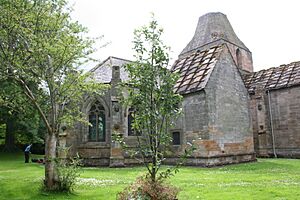Seton Collegiate Church facts for kids
Seton Collegiate Church, also known as Seton Chapel, is a very old and special church located south of Port Seton in East Lothian, Scotland. It stands right next to Seton House. This church is so important that it's protected as a scheduled monument, which means it's a historic site that must be preserved.
Contents
What Seton Collegiate Church Looks Like
This church is shaped like a cross, which is called a cruciform design. It has the main eastern part, two side sections called transepts, and a tower in the middle. The tower was never fully finished with a tall spire because of a big historical event called the Scottish Reformation. The Reformation was a time in the 1500s when many people in Scotland changed their religious beliefs and practices.
The walls of the main eastern part of the church, including the choir and chancel, were built by 1478. The roof was added by 1508. The two side transepts were built later, between 1513 and 1588. This means the eastern part of the church stood on its own for at least 35 years before the sides were added!
In 1492, the church became a "collegiate church." This meant it had a group of priests, called a college, who lived and worked there, praying and performing services. Inside the church, you can see two old statues, called effigies. These statues show a man and a woman from the 1400s. The female statue is quite damaged, and some people think it might be even older.
Buildings for the Clergy
Just to the southwest of the church, you can still see the foundations of buildings where the priests and other church staff used to live.
A Time of War
During a war known as the Rough Wooing, the English army took control of a nearby town called Haddington. This war happened in the mid-1500s. Because of the fighting, the Seton family, who were important people connected to the church, had to leave their home. In 1549, George Seton, 6th Lord Seton, died while his family was staying at Culross Abbey. After the war ended, his wife, Marie Pieris, had his body brought back to Seton. He was buried in the church's choir, right next to his father.
Seton Church Today
Today, Historic Environment Scotland takes care of Seton Collegiate Church. It's a popular place for visitors and is rated as a 4-Star Historic Tourist Attraction. In the churchyard, you can also see pieces of stone from the old Seton Palace, which used to be next door but was torn down a long time ago.
Photo gallery










